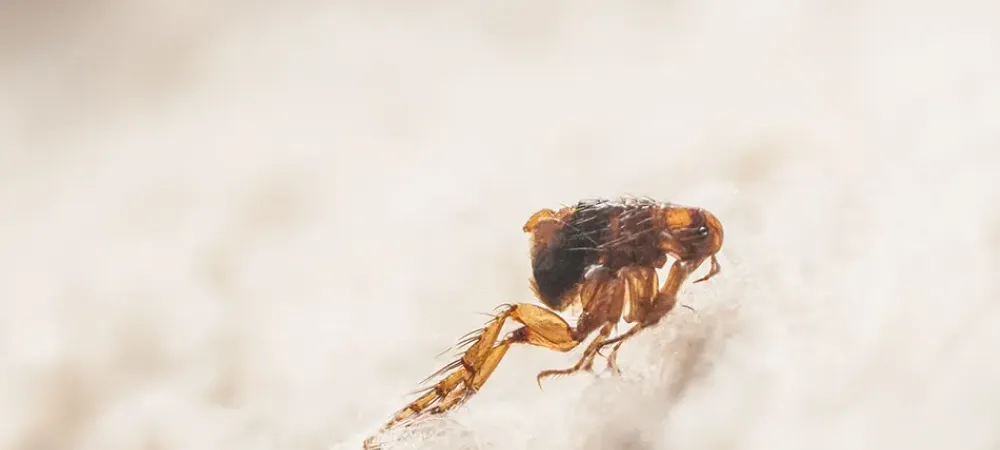How to Know if Your Dog Has Fleas

As any Alabama dog owner knows, our warm, humid climate is paradise for fleas. With long spring and summer seasons and mild winters, fleas can thrive here nearly year-round. That makes it especially important for pet parents in Alabama to know how to spot fleas early—and take quick action to protect their dogs, homes, and families.
Signs Your Dog Might Have Fleas
Fleas are tiny but mighty pests. Here are the telltale signs to watch for:
If your dog is showing one or more of these signs, it’s time to move on to a full flea check and treatment plan. Catching fleas early can make a huge difference—not only in your dog’s comfort, but in preventing a full-blown infestation in your home.
Scratching, Biting, or Licking More Than Usual
This is often the very first sign. If your dog seems obsessed with scratching or biting certain areas—particularly around the neck, belly, back, tail base, or inner thighs—fleas could be the cause.
- Dogs often bite at itchy spots or lick themselves excessively to soothe the irritation caused by flea bites.
- You might also see your dog suddenly jump or twitch while lying down or walking—this is sometimes a reaction to a flea bite.
Note for Alabama owners: Flea activity spikes after rains and in high humidity—if your dog has been outside after a wet, warm day, a sudden increase in scratching may be flea-related.
Hair Loss, Scabbing, or Hot Spots
If your dog has a flea allergy (Flea Allergy Dermatitis or FAD), even one bite can cause intense irritation. Common symptoms include:
- Hair thinning or bald patches, especially near the base of the tail, thighs, belly, and neck.
- Red, inflamed skin or raised bumps.
- Open sores or hot spots, where your dog has chewed or scratched the skin raw.
These symptoms can worsen quickly, especially in Alabama summers when heat and humidity exacerbate skin issues. If you notice these signs, consult a veterinarian right away to avoid secondary infections.
Black Specks (Also Known as Flea Dirt)
Flea dirt is the waste left behind by adult fleas and is one of the clearest signs that fleas are present—even if you don’t see the fleas themselves.
Here’s how to check for it:
- Look along your dog’s back, belly, and inside of their thighs—areas fleas tend to hide.
- Use a fine-toothed comb (like a flea comb) to pull out debris.
Tap the comb over a white paper towel or cloth. - Lightly wet the specks with a little water.
If the black specks turn a reddish-brown color, it’s flea dirt. That color change is due to the digested blood in flea waste.
Visible Fleas
Spotting actual fleas confirms an infestation, but they can be tricky to see.
- Adult fleas are about the size of a sesame seed—roughly 1/8 inch long.
- They’re reddish-brown, wingless, and can move quickly through your dog’s fur.
- You may see them crawling or jumping, especially on areas where the fur is thinner (like the belly, inner thighs, or around the ears).
Important: Just because you don’t see fleas doesn’t mean your dog doesn’t have them. Fleas are fast, and some dogs groom them off quickly. That’s why checking for flea dirt is often more effective.
How to Check Your Dog for Fleas at Home
Here’s how to inspect your dog for fleas using tools you probably already have at home or can pick up for a few bucks.
What You’ll Need:
- Flea comb (fine-toothed and widely available at pet stores)
- White towel, sheet, or paper towel
- A bowl of warm soapy water (dish soap works great)
- Bright lighting or a flashlight
Step-by-Step Instructions:
- Set up a clean, well-lit area. Lay the white towel on a flat surface to catch any falling debris or fleas.
- Position your dog comfortably. If they’re wiggly, try giving them a chew or treat to distract them.
- Start combing your dog’s fur slowly. Focus on high-risk areas:
- Neck and shoulders
- Behind the ears
- Under the front legs (armpits)
- Belly and groin
- Around the tail and hindquarters
- After each stroke, check the comb.
- You might see actual fleas (tiny, reddish-brown, fast-moving).
- You might find “flea dirt.” To test if it's flea dirt: rub a few specks onto a damp paper towel—if it turns reddish brown, that’s digested blood, confirming fleas.
- Dip the comb into the bowl of soapy water after each pass to trap and kill any fleas you find.
Don’t forget: Fleas can be hard to see on dogs with thick or dark coats. Use a flashlight if needed to inspect the skin closely.

What To Do If Your Dog Has Fleas
If you find fleas on your dog, don’t panic—just act fast.
Use Vet-Approved Flea Treatment
Start by calling your local vet in Alabama and discussing which product is best based on your dog’s age, weight, and health.
Common treatments include:
- Giving your dog a flea bath using a medicated shampoo designed to kill fleas.
- After drying, applying a vet-approved flea treatment (like a topical or oral product).
Popular vet-recommended options in Alabama include: - Simparica Trio (oral, fast-acting)
- NexGard (chewable)
- Frontline Plus (topical)
- Seresto collar (long-lasting and water-resistant)
Clean Your Home
Fleas lay eggs in carpets, furniture, and bedding. Start trying your home:
- Wash all pet bedding, throw blankets, and soft toys in hot water.
- Vacuum all carpets, rugs, couches, and furniture daily for at least a week.
- Consider using a pet-safe flea spray or fogger if the infestation is moderate to severe.
- Empty your vacuum outside after each use (flea eggs can hatch in the vacuum bag or canister).
Treat the Yard
In Alabama, fleas love shaded, damp spots like under porches, decks, and thick shrubs.
- Mow the lawn regularly.
- Remove leaf piles or shaded debris where fleas might hide.
- Use outdoor flea control sprays or natural options like diatomaceous earth or beneficial nematodes (available at Tractor Supply or garden centers).
- Focus on shady areas where your dog likes to rest.
Stay on a Year-Round Preventative
In Alabama, flea prevention isn't just for summer. Our long warm seasons mean fleas can survive nearly all year, especially in South Alabama or the coastal regions.
Prevention Tips:
- Use year-round flea prevention. Missing just one month can give fleas a chance to come back.
- Keep the yard trimmed and clean. Don’t let piles of leaves or brush collect.
- Brush your dog weekly with a flea comb as a regular check-up.
- Schedule regular vet visits to ensure your dog stays flea-free and healthy.
Consider Local Resources for Alabama Pet Owners
- Alabama Veterinary Medical Association (ALVMA) – Find a trusted local vet.
- Alabama SPCA – Offers pet care education and sometimes low-cost flea prevention.
- Pet Supplies Plus, Tractor Supply, and local feed stores – Great spots for flea products suited for Southern climates.
When to Call in the Pros: Partner with Defense Pest Solutions
Sometimes, despite your best efforts, fleas can dig in and become a major problem—especially in Alabama’s warm, humid environment where they can reproduce rapidly indoors and out. If you're dealing with a stubborn flea infestation or want a professional solution to protect your home, Defense Pest Solutions is your go-to local expert for flea control.
Why Choose Defense Pest Solutions?
- Targeted Indoor and Outdoor Flea Treatments: Defense uses professional-grade products to eliminate fleas where they live and breed—inside your home and throughout your yard.
- Pet- and Family-Safe Solutions: Treatments are carefully chosen to be safe for your pets and loved ones, while effectively breaking the flea life cycle.
- Locally Owned, Alabama Trusted: As a locally owned and operated company, Defense understands how Alabama’s climate impacts flea activity. They use that knowledge to customize treatments for maximum effectiveness.
- Comprehensive Pest Plan: Fleas often go hand-in-hand with other pests like ticks and ants. Defense Pest Solutions offers full-service pest control plans to keep your home protected year-round.
When to Call Our Flea Exterminators?
- If you’ve treated your dog but fleas keep coming back.
- If you’re finding fleas in your carpet, furniture, or bedding.
- If you want a preventative yard spray during peak flea seasons (spring through early fall in Alabama).
- If your pet has had multiple infestations in one year.
